This week I had the privilege of attending a small media event to learn about all things apples, as the 2011 Australian picking season was launched. I’ve grown up with plenty of farm holidays and have seen apples literally growing on trees, but even as a dietitian and foodie I was caught up in some urban myths. How about you? Did you know that…..
Superfood status
One apple has twice the antioxidant activity of a cup of green or black tea and more antioxidants than 1/2 punnet of blueberries. Amazing, but true. Last year we reported on the 2010 Apple Report, an in depth look at ten years of accumulated research on apples and health by Australian research body CSIRO. Dietitian spokesperson for Aussie Apples, Karen Kingham says, “The latest research shows snacking on whole apples may help with weight loss, especially belly fat, and emerging science shows eating apples may reduce asthma and allergy symptoms like sneezing.” Apple phytonutrients including polyphenols are concentrated in the skin, so get into the habit of eating them whole not peeled. Cutting extra thin slices can help kids tackle the skin and chew it down.
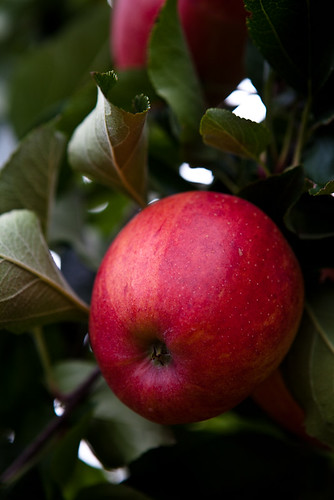
Beware of the chills?
Yes, apples can be stored for long periods of time and it is dangerous for humans to enter the storage chambers. But it is not a harmful, toxic gas. Rather the atmosphere is changed and is devoid of oxygen. Anyone entering the chamber will pass out simply from lack of oxygen. This gas and cold temperature (around 0.5 degrees Celsius) slows down the rate at which apples breathe (respiration) and mature. Apples have been traditionally stored for periods in the cold in order for them to be enjoyed out of season and they still retain dietary fibre, important nutrients and antioxidants. In fact, in 1873 the first export shipment of Aussie apples was sent to the Vienna Exhibition in the ice-room of a steamship. And believe me, the Granny Smith apple we tasted straight out of 9 months in cold store was crisp and delicious.

So mature
Apples mature at different rates depending on their variety and the environmental conditions during the season. There are 6 criteria used to measure maturity: firmness measured with a penetrometer; sugar; starch; red and then green colour intensity as well as colour coverage around the apple. A crisp, sweet tasting apple needs to have the balance of starch to sugar conversion just right. This process is measured before and after picking to deliver apples at their sweetest best. Here you can see two apples (sprayed with iodine) to demonstate where the starch (purple) has started to break and convert into sugar in the one on the left. The apple on the right has fully converted.
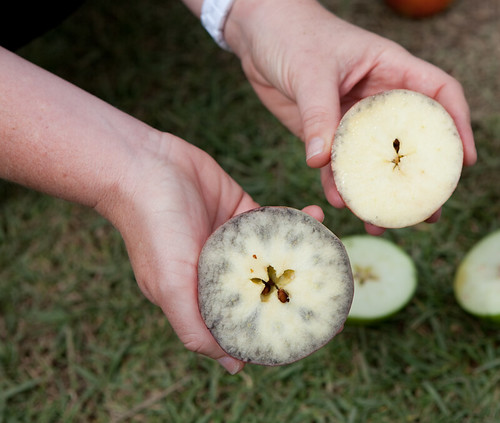
Pick on me
If you thought your apple was jostled out of the tree by some huge computerised machine think again. Aussie apples are still hand picked. Each one by a human being, straight off the tree into a belted bag and then carefully emptied into a wooden apple bin. Yes there are pesticides used in apple orchards, just like in modern horticultural practices that are not organically certified. However the industry admits that they have “learnt from organic farmers” and are conservative as they can be with pesticide use to eradicate moths and other pests that could wipe out the whole crop. Levels of chemical residues in foods in Australia are consistently found to be very low and below safety limits. Washing fresh produce will minimise pesticide contact and of course there is always organic. You can read more about the regulatory process with pesticides on the FSANZ website.

Wax lyrical
Yes apples are waxed. And before you turn up your nose to complain, let me tell you that we (the consumer) are to blame. You see apples naturally produce a waxy substance that coats and protects the skin and when rubbed on your jeans or shirt sleeve gives that glorious shine. But this natural wax produces a rather tacky feel and can leave a residue on your hands or clothing. So from early on apples have been washed and resprayed lightly with a vegetable based oil to reproduce that shine without the stickiness. Montague Orchards have consumer tested different apple batches. And time and time again subjects go for the vegetable oil waxed over the natural one. They wish it was the other way. Isn’t that so tacky.
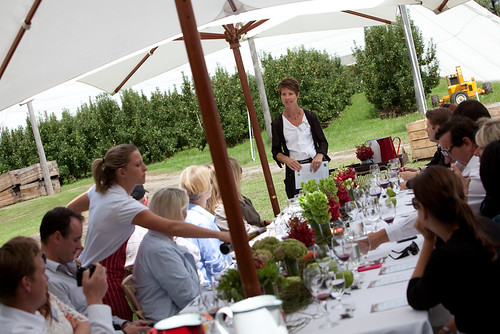
That’s import-ant
Until recent times, Aussie Apples were all you could find in our stores and markets, but now imports are open and rolling in. You will already find apples from China, and soon New Zealand and the USA. Now there’s nothing wrong with apples from other countries. In fact I loved eating my Fuji apple while travelling past Mount Fuji in Japan. And I heart apple varieties that I’ve enjoyed in the USA. Check out my friend and dietitian blogger Janel Orvut’s orchard adventures on her blog Eat Well with Janel. But the important message is that when you buy local, home grown apples they are going to be better for you and the environment. Simply because they haven’t had to travel for miles, have had less handling and less chance of the supply chain, cold store being broken or disrupted. In Australia, Coles and Woolworths have committed to stocking Aussie Apples, but you may need to ask your independent grocer or check apple sticker labels. The main apple varieties grown in Australia are Red Delicious, Granny Smith, Royal Gala, Fuji, Cripps Pink (Pink Lady TM) and Cripps Red (SundownerTM). But Montague Orchards are singing from the trees about new, superior varieties like JazzTM.
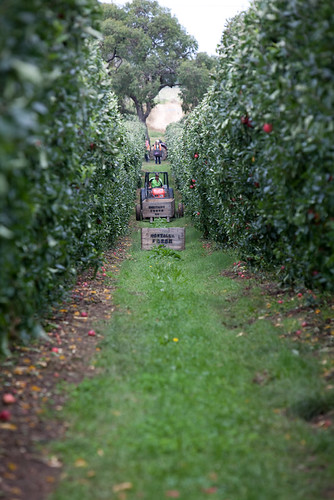
Pack it in
Our hosts the Montague family who have been growing apples for three generations, take an incredibly sophisticated and lovingly dedicated approach to ensuring superior apple quality from paddock to plate. And yes that includes working with the major retailers behind the scenes, out back. Apples are graded for quality using the human hand as well as new technology that can pinpoint blemishes inside right to the core. If you’ve experienced a floury apple or a teeth wincing, extra tart Granny Smith labelled as “seasons best” you should ask your fresh produce supplier for the packing slip and give feedback to the grower. All apples are packed with origin and date stickers and you can ask to see these in store. Believe me after all the hard work and love that goes into apple growing, the orchard certainly wants to hear and followup on any problems with quality outside the farm gate.
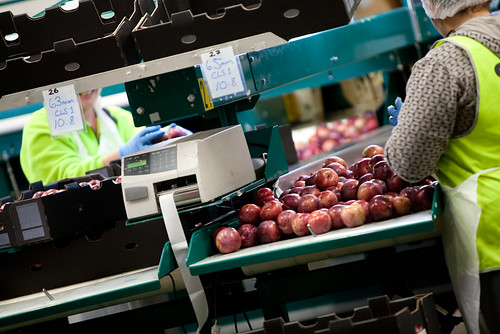
Last bite
With so much rich apple, growing tradition comes fabulous heirloom recipes handed down from generation to generation. Now our dessert below will take a bit of work, but you’ll love the 100 Year Old Mason’s Honey Baked Apple recipe for a quick family meal. And jump across to One a day superfood for more. Love to hear your applecious recipes, tips and stories too in our comments below. Or perhaps you have a question on apples, still unanswered?
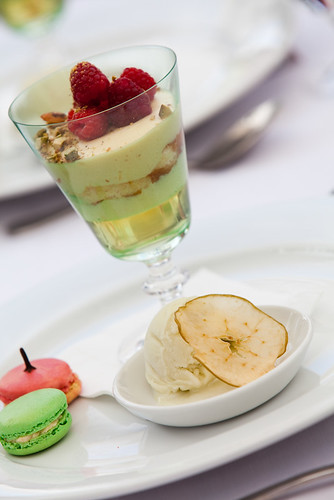
Disclosure: Emma Stirling is great friends with Karen Kingham the Aussie Apples dietitian which may have swayed her love of apples just a little. Media were treated to a sumptuous lunch under the orchard by Peter Rowland catering and gifted some fresh Royal Galas to bring home. The event was co-ordinated by Bite Communications on behalf of Apple and Pear Association Limited, Aussie Apples and Montague Orchards.